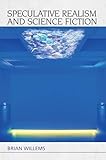Speculative Realism and Science Fiction / Brian Willems.
Material type: TextSeries: Speculative Realism : SPREPublisher: Edinburgh : Edinburgh University Press, [2022]Copyright date: ©2017Description: 1 online resource (240 p.) : 1 B/W illustrations 1 B/W tablesContent type:
TextSeries: Speculative Realism : SPREPublisher: Edinburgh : Edinburgh University Press, [2022]Copyright date: ©2017Description: 1 online resource (240 p.) : 1 B/W illustrations 1 B/W tablesContent type: - 9781474422697
- 9781474422710
- PN3433.5 .W55 2017
- online - DeGruyter
| Item type | Current library | Call number | URL | Status | Notes | Barcode | |
|---|---|---|---|---|---|---|---|
 eBook
eBook
|
Biblioteca "Angelicum" Pont. Univ. S.Tommaso d'Aquino Nuvola online | online - DeGruyter (Browse shelf(Opens below)) | Online access | Not for loan (Accesso limitato) | Accesso per gli utenti autorizzati / Access for authorized users | (dgr)9781474422710 |
Frontmatter -- Contents -- Acknowledgements -- Series Editor’s Preface -- Introduction -- 1 The Zug Effect -- 2 Divine Paraphrase: Cormac McCarthy -- 3 Double-Vision: Neil Gaiman -- 4 Subtraction and Contradiction: China Miéville -- 5 Tension and Phase: Doris Lessing -- 6 Animal Death: Paolo Bacigalupi -- 7 Transcription: Kim Stanley Robinson -- Conclusion -- Bibliography -- Index
restricted access online access with authorization star
http://purl.org/coar/access_right/c_16ec
Imagines the end of anthropocentrism through contemporary science fiction and speculative realismA human-centred approach to the environment is leading to ecological collapse. One of the ways that speculative realism challenges anthropomorphism is by taking non-human things to be as valid objects of investivation as humans, allowing a more responsible and truthful view of the world to take place. Brian Willems uses a range of science fiction literature that questions anthropomorphism both to develop and challenge this philosophical position. He looks at how nonsense and sense exist together in science fiction, the way in which language is not a guarantee of personhood, the role of vision in relation to identity formation, the difference between metamorphosis and modulation, representations of non-human deaths and the function of plasticity within the Anthropocene. Willems considers the works of Cormac McCarthy, Paolo Bacigalupi, Neil Gaiman, China Miéville, Doris Lessing and Kim Stanley Robinson are considered alongside some of the main figures of speculative materialism including Graham Harman, Quentin Meillassoux and Jane Bennett.
Mode of access: Internet via World Wide Web.
In English.
Description based on online resource; title from PDF title page (publisher's Web site, viewed 29. Jun 2022)


